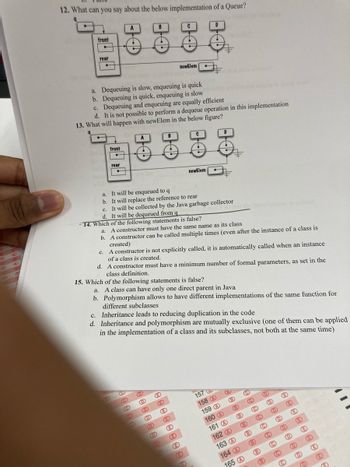
Database System Concepts
7th Edition
ISBN: 9780078022159
Author: Abraham Silberschatz Professor, Henry F. Korth, S. Sudarshan
Publisher: McGraw-Hill Education
expand_more
expand_more
format_list_bulleted
Concept explainers
Question
Urgent

Transcribed Image Text:9
B
B
B
C
12. What can you say about the below implementation of a Queue?
•
front
rear
.
ut
front
rear
a. Dequeuing is slow, enqueuing is quick
b. Dequeuing is quick, enqueuing is slow
c. Dequeuing and enqueuing are equally efficient
d. It is not possible to perform a dequeue operation in this implementation
13. What will happen with newElem in the below figure?
q
A
A
B
C
Ⓒ
C
C
B
3
a. It will be enqueued to q
b. It will replace the reference to rear
C
newElem
D
D
(D)
D
c. It will be collected by the Java garbage collector
d. It will be dequeued from q
-14. Which of the following statements is false?
O
D
C
a. A constructor must have the same name as its class
b. A constructor can be called multiple times (even after the instance of a class is
created)
15. Which of the following statements is false?
newElem
c. A constructor is not explicitly called, it is automatically called when an instance
of a class is created.
d. A constructor must have a minimum number of formal parameters, as set in the
class definition.
E
(E)
E
(E)
(E)
(E)
BO
a. A class can have only one direct parent in Java
b. Polymorphism allows to have different implementations of the same function for
different subclasses
c. Inheritance leads to reducing duplication in the code
d. Inheritance and polymorphism are mutually exclusive (one of them can be applied
in the implementation of a class and its subclasses, not both
at the same time)
E
(E)
(E)
D
157 C
158
159
160
161
162 @
163
164
165
(B
B
(B)
(B)
(B)
(B)
(B)
(B)
(B)
©
(C)
C
Ⓒ
(C)
C
(C)
C
OD
O
(D)
(D
(D)
(D)
D
(D)
(E)
(E
(E
(E
E
(E)
(E)
(E)
Expert Solution
This question has been solved!
Explore an expertly crafted, step-by-step solution for a thorough understanding of key concepts.
Step by stepSolved in 3 steps with 2 images

Knowledge Booster
Learn more about
Need a deep-dive on the concept behind this application? Look no further. Learn more about this topic, computer-science and related others by exploring similar questions and additional content below.Similar questions
- Please provide a numbered list of the procedures required to boot a computer.arrow_forwardFTP files kjchfhfhhhhhhhhhhhhhhhhhhhhhhhhhhhhhhhhhhhhhhhhhhhhhhhhhhhhhhhhhhhhhhhhhhhhhhhhhhhhhhhhhhhhhhhhhhhhhhhhhhhhhhhhhhhhhhhhhhhhhhhhhhhhhhhhhhhhhhhhhhhhhhhhhhhhhhhhhhhhhhhhhhhhhhhhhhhhhhhhhhhhnhhhhhhhhhhhhhhhhhhhhhharrow_forwardExplain why organizations use cloud computing.arrow_forward
Recommended textbooks for you
 Database System ConceptsComputer ScienceISBN:9780078022159Author:Abraham Silberschatz Professor, Henry F. Korth, S. SudarshanPublisher:McGraw-Hill Education
Database System ConceptsComputer ScienceISBN:9780078022159Author:Abraham Silberschatz Professor, Henry F. Korth, S. SudarshanPublisher:McGraw-Hill Education Starting Out with Python (4th Edition)Computer ScienceISBN:9780134444321Author:Tony GaddisPublisher:PEARSON
Starting Out with Python (4th Edition)Computer ScienceISBN:9780134444321Author:Tony GaddisPublisher:PEARSON Digital Fundamentals (11th Edition)Computer ScienceISBN:9780132737968Author:Thomas L. FloydPublisher:PEARSON
Digital Fundamentals (11th Edition)Computer ScienceISBN:9780132737968Author:Thomas L. FloydPublisher:PEARSON C How to Program (8th Edition)Computer ScienceISBN:9780133976892Author:Paul J. Deitel, Harvey DeitelPublisher:PEARSON
C How to Program (8th Edition)Computer ScienceISBN:9780133976892Author:Paul J. Deitel, Harvey DeitelPublisher:PEARSON Database Systems: Design, Implementation, & Manag...Computer ScienceISBN:9781337627900Author:Carlos Coronel, Steven MorrisPublisher:Cengage Learning
Database Systems: Design, Implementation, & Manag...Computer ScienceISBN:9781337627900Author:Carlos Coronel, Steven MorrisPublisher:Cengage Learning Programmable Logic ControllersComputer ScienceISBN:9780073373843Author:Frank D. PetruzellaPublisher:McGraw-Hill Education
Programmable Logic ControllersComputer ScienceISBN:9780073373843Author:Frank D. PetruzellaPublisher:McGraw-Hill Education

Database System Concepts
Computer Science
ISBN:9780078022159
Author:Abraham Silberschatz Professor, Henry F. Korth, S. Sudarshan
Publisher:McGraw-Hill Education

Starting Out with Python (4th Edition)
Computer Science
ISBN:9780134444321
Author:Tony Gaddis
Publisher:PEARSON

Digital Fundamentals (11th Edition)
Computer Science
ISBN:9780132737968
Author:Thomas L. Floyd
Publisher:PEARSON

C How to Program (8th Edition)
Computer Science
ISBN:9780133976892
Author:Paul J. Deitel, Harvey Deitel
Publisher:PEARSON

Database Systems: Design, Implementation, & Manag...
Computer Science
ISBN:9781337627900
Author:Carlos Coronel, Steven Morris
Publisher:Cengage Learning

Programmable Logic Controllers
Computer Science
ISBN:9780073373843
Author:Frank D. Petruzella
Publisher:McGraw-Hill Education